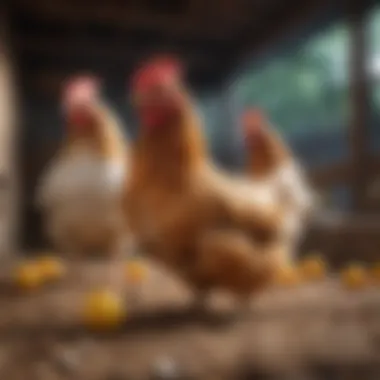Best Online Chicken Coop Options for Every Owner


Intro
In recent years, raising chickens at home has grown in popularity. Many people are turning towards this rewarding and sustainable practice. As such, understanding the many facets of chicken coops becomes essential. This guide aims to highlight the myriad chicken coop options available online. It will detail what to consider when purchasing, ensuring that both novice and experienced chicken owners can make informed choices.
A chicken coop must provide safety, comfort, and an environment conducive to natural behaviors. Buyers must weigh options between pre-built and DIY coops, considering their specific needs, the size of their flock, and overall budget. This guide will cover the variety available, the features to expect, and the right maintenance practices to adopt for a successful chicken-raising endeavor.
Types of Chicken Coops
When selecting a chicken coop, one should recognize the types available. Here are a few prominent categories:
- Pre-Built Coops: These coops are ready to use upon delivery. They often come with specific features that ensure safety and comfort.
- DIY Coops: An interesting avenue for those who enjoy hands-on projects. Building your own coop allows for customization but requires planning and practical skills.
- Mobile Coops: Mobile or “chicken tractors” allow for easy movement, providing fresh grass and reducing parasite load on the ground.
- Community Coops: Some urban areas have community coops where multiple people share costs and responsibilities for a bigger coop.
Understanding these types helps create a foundation for in-depth decisions regarding the best chicken coop.
Factors to Consider When Purchasing
The vital elements to consider before purchasing a chicken coop include:
- Space: Ensure adequate space for the number of chickens you plan to raise. Crowded conditions can lead to stress and health issues.
- Ventilation: Proper airflow is critical to maintain a healthy environment inside the coop. Insufficient ventilation can lead to respiratory problems.
- Security: Coops should be secure from predators. Look for solid materials and proper locks.
- Ease of Cleaning: A coop that can be easily cleaned will simplify maintenance. Look for features like removable roosts and sliding trays.
- Accessibility: Having easy access to feed and water sources will encourage regular care. Design plays a big role in this aspect.
Evaluating these factors will help narrow down choices to the most suitable options.
Advantages and Disadvantages of Pre-Built vs.
DIY Coops
Both pre-built and DIY coops have distinct pros and cons:
Pre-Built Coops
- Advantages:
- Disadvantages:
- Ready to use, reducing initial setup time.
- Often come with warranties and guarantees.
- Designed by experts, typically providing good insulation and ventilation.
- More expensive than DIY options.
- Limited customization.
DIY Coops
- Advantages:
- Disadvantages:
- Full control over design and materials.
- Often more cost-effective if you already have tools and materials.
- Required time for construction and planning.
- Potential knowledge gaps leading to problems in the structure.
Each option has its own appeal, depending on budget, time constraints, and personal preferences.
Maintenance Tips for Chicken Coops
It is crucial to maintain a chicken coop to ensure the health of the flock. Here are necessary maintenance tips:
- Regular Cleaning: Ensure that droppings and waste are cleaned weekly to prevent disease.
- Check for Pests: Inspect the coop regularly for signs of parasites like mites and lice. Applying diatomaceous earth can help.
- Inspect Structural Integrity: Routinely check for holes or damages that might compromise safety.
- Provide Fresh Water: Ensure chickens always have access to clean water, especially in summer when heat can be intense.
- Update Bedding Material: Change bedding when it becomes soiled to provide a fresh, healthy environment.
Following these tips can enhance coop longevity and contribute to a thriving flock.
End
The journey of raising chickens starts with selecting the right chicken coop. Through this guide, we have explored various types of coops and the factors that influence purchasing decisions. Understanding the nuances between pre-built versus DIY options and the necessary maintenance practices is key to a successful chicken-raising experience. With informed choices, one can significantly enhance the welfare and productivity of their chickens.
Preamble to Chicken Coops
Chicken coops play a crucial role in the well-being of chickens and the overall chicken-raising experience. Understanding these structures is essential for anyone looking to embark on a journey with poultry. The need for proper housing cannot be overstated, as it directly affects the health, safety, and productivity of your flock.


Understanding Basic Chicken Requirements
To ensure that your chickens thrive, it is vital to comprehend their basic needs. Chickens require adequate space, ventilation, and appropriate environment to lead a healthy life. Each chicken should ideally have around four square feet of space in the coop with additional space in an outdoor run. Proper ventilation is also necessary to avoid moisture buildup, which can lead to respiratory issues. Furthermore, the coop should provide safety from predators while allowing the chickens to express natural behaviors such as scratching and pecking. This knowledge serves as the bedrock for selecting or constructing an appropriate coop.
Purpose of a Chicken Coop
The primary purpose of a chicken coop is to provide a safe and comfortable living space for chickens. It serves multiple functions:
- Protection from Weather: Coops shield chickens from harsh weather conditions, including rain, snow, and extreme heat.
- Safety from Predators: A well-built coop keeps chickens secure from potential threats like raccoons, foxes, and birds of prey.
- Egg Production: A properly designed coop enhances egg-laying conditions, leading to better yield and quality.
Types of Chicken Coops Available Online
Understanding the different types of chicken coops available online is integral for anyone interested in raising chickens. It allows potential chicken owners to determine which option best meets their needs, the needs of their birds, and the specifics of their living conditions. This section will explore three primary categories: pre-built chicken coops, DIY chicken coops, and mobile or portable chicken coops. Each type offers unique benefits and considerations that can greatly influence the success of a chicken-raising venture.
Pre-built Chicken Coops
Pre-built chicken coops are manufactured structures that arrive ready for assembly. These coops often come with detailed instructions, making them user-friendly for individuals who may be less handy or lack construction skills. Purchasing pre-built options can save time, providing a fast solution for those eager to raise chickens without the delays or challenges that building from scratch often presents.
Benefits of Pre-built Coops
- Ease of Assembly: Instructions are typically clear, and most individuals can assemble them with basic tools.
- Consistent Quality: Established brands often provide coops made from durable materials that meet standard requirements for chicken care.
- Variety: There is an extensive range of designs available, catering to different flock sizes, spaces, and aesthetics.
Pre-built coops can be excellent for urban environments where space is limited. Some models may even integrate designs that blend into backyard landscapes, maintaining aesthetic appeal while serving functional purposes. However, potential buyers should examine the dimensions and features closely to ensure suitability for their flock's needs.
DIY Chicken Coops
DIY chicken coops offer the allure of personalization and creativity. Chicken owners can design and build a coop that specifically suits their flock’s needs and their property’s layout. This option is popular among individuals who enjoy hands-on projects or want to ensure their coop is crafted from high-quality materials.
Benefits of DIY Coops
- Customization: Owners have the freedom to design the coop according to their specific needs, adjusting size, shape, and materials as necessary.
- Budget-Friendly: Depending on available materials, DIY coops can be more cost-effective than purchasing a pre-built option.
- Satisfaction: Successfully building a coop can provide a significant sense of accomplishment.
While DIY projects can be rewarding, they also require planning and effort. It is critical to research coop design to ensure it meets health and safety standards, as well as the specific requirements of the chickens.
Mobile and Portable Chicken Coops
Mobile or portable chicken coops, often referred to as
Factors to Consider When Choosing a Coop
Choosing the right chicken coop is vital for the success of your poultry-raising efforts. The coop is more than just a structure; it serves as a sanctuary for your chickens, ensuring their safety, health, and productivity. Several factors influence this decision, and understanding them will lead to better outcomes for both you and your birds.
Space Requirements
When selecting a chicken coop, space is among the most critical factors. Chickens need enough room to move around freely. The general guideline is at least 4 square feet per chicken in the coop and 10 square feet in the outdoor run. Insufficient space can lead to stress, pecking, and other behavioral issues. Evaluate your yard or available land to determine the size of coop that fits your needs. Also, consider the coop layout; providing vertical space with perches can enhance comfort.
Material Choices
The material of your chicken coop affects durability and maintenance. Common materials include wood, metal, and plastic. Wood is often favored for its insulation properties, but it requires regular maintenance to prevent rot. Metal coops are sturdy and easy to clean, yet they can become very hot in summer. Plastic coops are lightweight and resistant to pests, but they might lack the aesthetic appeal some owners desire. Assess your local climate and personal preferences while selecting the materials for your coop.
Ventilation and Temperature Control
Good ventilation is paramount for a healthy coop environment. Proper airflow helps regulate temperature and prevents moisture accumulation, which can lead to respiratory issues in chickens. Look for coop designs that include windows, vents, or screens. In warmer climates, consider coops with a raised design to promote airflow underneath. In colder areas, need to balance ventilation with insulation to protect chickens from freezing temperatures. Keep these factors in mind for the overall well-being of your flock.
Predator Protection
Predators pose a serious threat to chickens. Securing your coop properly is crucial to minimize risks. Look for coops with solid construction materials, reinforced doors, and secure latches. Elevating the coop can also deter ground predators, while a fenced run can offer extra security. Often, it’s wise to add buried hardware cloth around the perimeter to prevent digging. Always inspect your coop regularly for signs of wear and potential breaches to keep your flock safe.
Ensuring the safety and comfort of your chickens not only protects the animals but also enhances their productivity and well-being. Making informed choices regarding space, materials, ventilation, and security will result in a successful chicken-raising experience.
Comparative Analysis of Leading Brands


Conducting a comparative analysis of leading brands serves as a fundamental step in making an informed purchase decision for a chicken coop. With a plethora of options available online, understanding the specific strengths and weaknesses of each brand can save time and lead to smarter choices. Factors such as durability, design, and customer service are paramount considerations, as they directly affect the longevity of the coop and the wellbeing of the chickens inside them.
The importance of this analysis extends beyond mere features. It provides insights into user experiences and potential pitfalls that may not be immediately visible from product descriptions or marketing. By comparing brands, chicken owners can identify coops that align with their particular needs, whether they prioritize aesthetics, ease of maintenance, or functionality.
Brand A: Overview and Key Features
Brand A has garnered considerable attention for its innovative designs and solid build quality. They offer various models tailored to specific chicken-keeping needs. A few key features typically associated with Brand A include:
- Solid Construction: Built from durable materials, ensuring longevity and safety.
- User-Friendly Design: Many models include easy access points for cleaning and egg collection.
- Flexible Sizes: Options available to fit different flock sizes and spaces.
User reviews often highlight the ease of assembly, which can be appealing for first-time chicken owners. Additionally, the aesthetic appeal often receives praise, making these coops suitable for backyards without looking out of place.
Brand B: Overview and Key Features
Brand B is known for prioritizing comfort and functionality in chicken coops. Their offerings reflect a commitment to the welfare of the chickens, with features designed to enhance their living environment. Notable aspects include:
- Ventilation Systems: Carefully designed to promote airflow, reducing moisture buildup and ensuring chicken health.
- Integrated Nesting Boxes: Often included with models, enabling secure and comfortable laying areas for hens.
- Predator-Proof Features: Enhanced security measures to protect chickens from common threats.
Buyers typically acknowledge these coops for their balance between functionality and aesthetics. The versatility in design allows options for various climates and geographic locations.
Brand C: Overview and Key Features
Brand C appeals to the DIY enthusiasts and those seeking to combine functionality with sustainability. They focus on eco-friendly materials and customizable options. Key features include:
- Eco-Friendly Materials: Coops are often made with sustainable wood and non-toxic finishes.
- Modular Design: Ability to expand or modify as the flock grows or needs change.
- Affordability: Generally priced lower than many competitors, appealing to budget-conscious buyers.
Customer feedback often highlights the adaptability of these coops. Be it through modifications or extensions, users find a cooperative community online that shares tips for maximizing the coop’s usage.
Ultimately, understanding the key features of each brand allows chicken owners to align their choice with their specific priorities, leading to greater satisfaction and better outcomes for their flock.
Advantages of Buying a Coop Online
Purchasing a chicken coop online offers several advantages that cater to both novice and experienced chicken owners. The convenience of digital shopping allows you to access a wide range of options without the constraints of geographical limitations. This section explores specific elements that highlight the benefits of buying a coop online, emphasizing the reasons it is a smart choice for many poultry enthusiasts.
Convenience of Online Shopping
Online shopping for chicken coops eliminates the need to travel to physical stores. You can browse various models from the comfort of your home. This is particularly beneficial for those who live in remote areas. Finding a local store that sells quality chicken coops can be a daunting task.
Additionally, online platforms are often available 24/7, allowing you to shop at your convenience. You can take your time to compare prices, features, and reviews without feeling rushed. The ability to shop from different retailers also means you have more flexibility to choose what best fits your requirements.
Wider Variety of Options
The variety available online is another significant advantage. You can access numerous brands and designs, many of which may not be available locally. Whether you're looking for a small coop for a few chickens or a larger setup for a bigger flock, the online marketplace is likely to have it.
Moreover, with options like custom builds or DIY kits, you have the luxury to find something that meets your exact needs. This wider variety ensures you can find coops made from different materials, sizes, and designs, providing you with ample choices.
User Reviews and Feedback
One of the most critical aspects of online shopping is the availability of user reviews. When considering a chicken coop, reading experiences from other buyers can provide insight that product descriptions may lack. Reviews can highlight potential issues, strengths, and real-world performance.
Feedback from fellow chicken owners offers a level of transparency that can significantly impact your decision-making process. You can gauge how easy the coop is to assemble, its durability, and how effectively it meets the needs of the chickens.
Aligning with user experiences can lead to more informed choices, reducing the risk of disappointment after purchase.
In summary, buying a coop online combines convenience, variety, and substantial user feedback. These advantages support a smoother purchasing journey and help ensure that you choose a coop that supports your chicken-raising goals.
Challenges of Buying a Coop Online
Buying a chicken coop online can seem simple due to the vast options available. However, it comes with its own unique challenges that potential buyers must navigate. Understanding these challenges is crucial to making an informed decision. Poor choices can lead to unsatisfactory purchases, impacting both the enjoyment of chicken-raising and the health of the flock.
Quality Assurance and Inspection


One significant challenge in purchasing a chicken coop online is ensuring quality assurance and inspection. When consumers shop locally, they have the opportunity to inspect the product physically. This allows them to assess materials, craftsmanship, and suitability for their specific needs. When buying online, however, buyers rely heavily on product descriptions and photos. This reliance can lead to discrepancies between expectation and reality.
To mitigate this risk, it is essential to research the seller and read through customer reviews to gauge the experiences of previous buyers. Focus on aspects such as:
- Material Quality: Look for details on what materials are used. Do they offer durability and protection?
- Construction: Consider feedback on how well the coop holds up in various weather conditions.
- Customer Service: Assess if the supplier has responsive customer support to address post-purchase concerns.
To ensure a satisfactory purchase, ask detailed questions before buying. This proactive approach may help in gathering insights that are not covered in product descriptions.
Delivery and Assembly Issues
The delivery and assembly process also presents challenges for buyers. There's a significant variance between coops in terms of assembly complexity. Some coops are designed for quick setup, while others may require advanced skills. Buyers must keep in mind the following:
- Delivery Delays: During peak seasons, such as spring, delivery times may extend beyond the expected dates. Confirm delivery schedules beforehand to avoid surprises.
- Assembly Instructions: Review the clarity of instructions provided. Some coops come with insufficient or confusing assembly guides.
- Missing Parts: Issues with missing parts can delay the setup process. Check return policies and ensure the company has a plan for resolving such issues.
In summary, while buying a chicken coop online offers numerous benefits, it is essential to acknowledge and address these challenges proactively. Buyers must prioritize quality assurance and be prepared for delivery and assembly complications. This understanding will lead to a more rewarding experience in chicken ownership.
Maintenance and Care for Chicken Coops
Maintaining a chicken coop is crucial for the well-being of the birds and the overall efficiency of the backyard farming operation. Proper maintenance helps to prevent disease, reduces odors, and ensures a safe living environment for your flock. It is not merely an optional task; rather, regular care is essential for the longevity of the coop itself and the productivity of the chickens housed within.
Regular Cleaning Protocols
Regular cleaning protocols are a fundamental aspect of chicken coop maintenance. The accumulation of waste can lead to health issues for chickens and unpleasant odors that may attract pests. It is advisable to implement a cleaning schedule that includes daily, weekly, and monthly tasks.
Daily tasks might include:
- Removing excess feed that the chickens did not eat. Stale food can attract rodents and other unwanted animals.
- Checking water sources and cleaning them as necessary to prevent contamination.
- Inspecting the coop for any signs of health issues or stress among the chickens.
Weekly tasks are more comprehensive and might involve:
- Removing old bedding and replacing it with fresh material. Straw or wood shavings are popular choices.
- Disinfecting surfaces where chickens spend the most time to minimize pathogens. A solution of vinegar and water can be effective and safe.
- Cleaning and checking nesting boxes to ensure they are dry and free from debris.
Monthly tasks focus on deeper sanitation, such as:
- Thoroughly scrubbing the entire coop, including all surfaces and corners. This removes stubborn stains and ensures there are no hidden areas for bacteria to thrive.
- Inspecting the coop for wear and tear, making necessary repairs to maintain a secure environment.
- Checking ventilation systems to ensure proper airflow althroughout the structure. Good ventilation reduces moisture and keeps the coop comfortable.
Potential Impact on Chicken Health and Productivity
The design and environment of a chicken coop can greatly affect the health and productivity of the chickens it houses. Understanding these impacts is essential for anyone serious about chicken keeping. A well-designed coop not only shields the birds from environmental threats but also promotes their natural behaviors, which can lead to improved health and better egg production. Thus, choosing the right coop is more than just a matter of aesthetics; it is a critical part of chicken care that has long-term consequences.
Effects of Coop Design on Behavior
The physical layout of a chicken coop influences how hens interact with each other and their environment. Key design elements include space, perches, and nesting areas. Chickens are social animals and need enough room to move freely. When overcrowded, they may experience stress, leading to aggressive behaviors such as pecking.
- Space Requirements: Providing sufficient floor space for each hen is vital. Ideally, each hen should have at least 4 square feet of indoor space.
- Perches: Higher perches allow chickens to establish a hierarchy. This is crucial for reducing conflict among pecking orders.
- Nesting Boxes: Enough nesting boxes should be available to reduce competition. A good rule is one box for every three hens.
The design must foster natural behaviors like foraging and dust bathing. Coops that allow access to outdoor runs provide opportunities for these activities, positively affecting the chickens’ mental and physical health.
Closure and Future Considerations
In this section, we review the significance of chicken coops in the context of raising healthy and productive chickens. The choice of a chicken coop impacts not only the comfort of the birds but also their overall well-being and productivity. It is critical to recognize how various factors, such as design, material, and maintenance, play key roles in ensuring optimal conditions for your chickens.
Investing in a high-quality chicken coop can lead to better egg production and improved chicken health. understanding the features and needs of your flock is essential in making the right decision. New technologies and trends in coop designs are emerging, which makes staying informed paramount for both novice and seasoned chicken owners.
"A well-designed coop serves as a sanctuary for chickens, promoting health and productivity."
Summarizing Key Takeaways
- The importance of design: Proper coop design plays a direct role in chicken behavior and productivity.
- Material choices matter: Selecting durable and safe materials for the coop can prevent issues related to health or maintenance down the line.
- Maintenance is vital: Regular cleaning and seasonal upkeep are necessary to ensure a healthy living environment for your flock.
- Future trends are worth noting: Innovations in chicken coop design are evolving, enhancing comfort and efficiency.
By understanding these key takeaways, hen keepers can create a productive and comfortable environment for their chickens. This is significant in fostering a sustainable practice in poultry rearing.
Looking Ahead: Trends in Chicken Coop Design
As more people take interest in backyard poultry farming, the demand for innovative chicken coop design continues to grow. Several trends are emerging that provide insight into the future of chicken coops:
- Sustainability is now a major focus, with many coops being designed from recycled or eco-friendly materials.
- Smart technology is gaining traction as coop owners explore options for automated systems that monitor temperature and humidity levels, ensuring optimal conditions.
- Aesthetic appeal is also crucial. Modern designs prioritize visual appeal, making them not just functional but also attractive attractions in backyards.
The shift towards these trends indicates a growing appreciation for the importance of a conducive environment for raising chickens. By keeping these considerations in mind, chicken owners can adapt and innovate their coop choices to enhance the quality of their poultry-raising experience.







